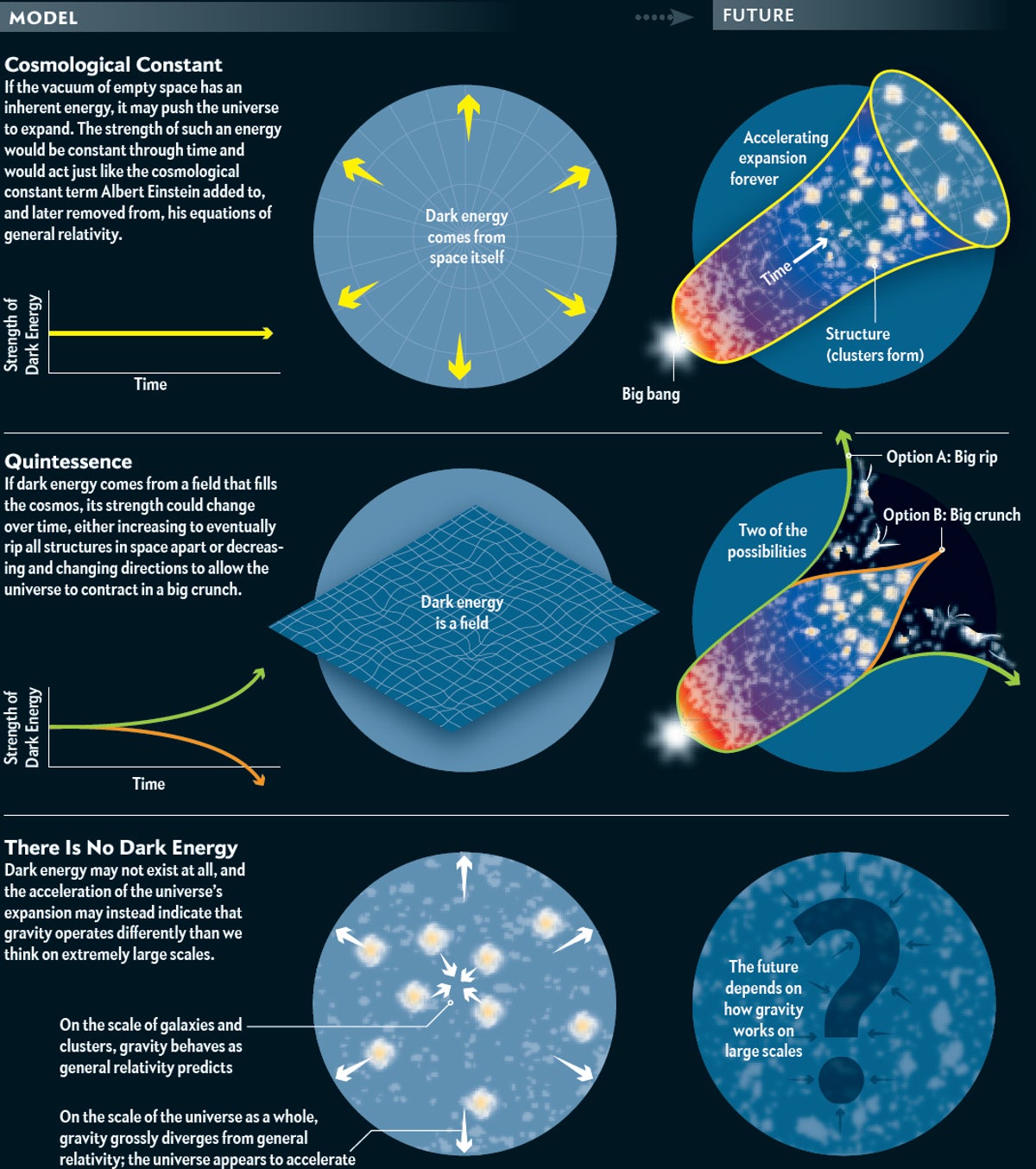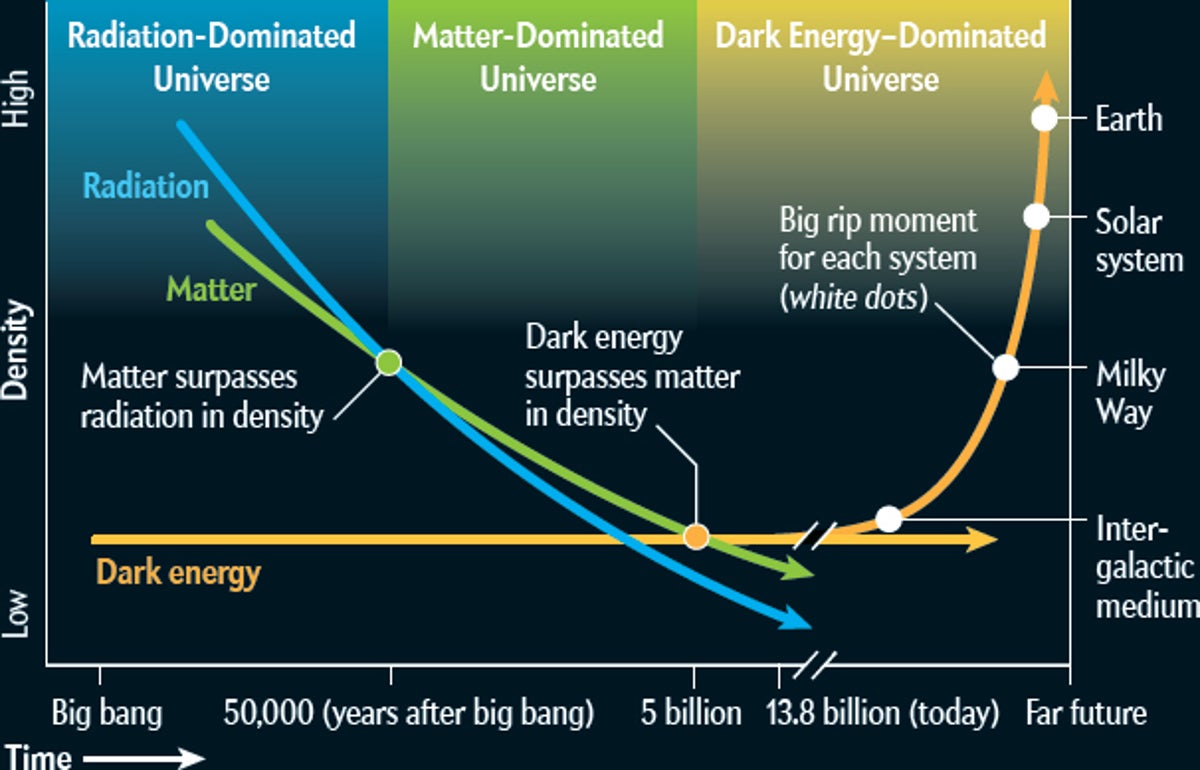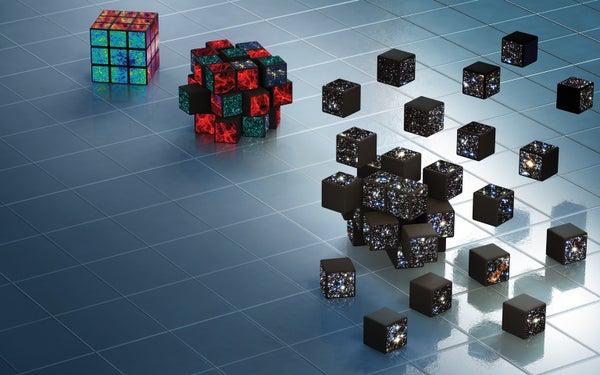The universe is getting bigger every second. Galaxies are flying apart from one another, clusters of galaxies are zooming away from other clusters, and the empty space between everything is growing wider and wider. This much was known since the 1920s, when observations by Edwin Hubble and others revealed that the cosmos is expanding. But more recently, astronomers found that the process is speeding up—the pace of the expansion of the universe is rising, so that galaxies are receding from one another faster now than they were a moment ago. This is the startling realization that one of us (Riess), along with collaborators he co-led with Brian Schmidt of the Australian National University, came to in 1998 through measurements of distant supernovae explosions.
The discovery agreed with findings from another team led by Saul Perlmutter of the University of California, Berkeley, using a similar method published the same year. The conclusion was unavoidable—something was causing the expansion of the universe to pick up speed. But what?
We give the name “dark energy” to whatever is causing the repulsive force that is apparently pulling the universe apart. After studying the situation for two decades, the physical nature of dark energy remains almost as elusive today as it was 20 years ago.
On supporting science journalism
If you're enjoying this article, consider supporting our award-winning journalism by subscribing. By purchasing a subscription you are helping to ensure the future of impactful stories about the discoveries and ideas shaping our world today.
We are left with several pressing mysteries: What is dark energy? Why does it seem so much weaker than the most straightforward theories predict (and yet strong enough that we detect it)? What does the nature of dark energy mean for the future of the universe? And finally, do the strange characteristics of dark energy imply that our universe got its properties randomly—that in fact, our universe is just one of a vast multiverse containing untold versions of the cosmos, each with different traits and different strengths of dark energy?
An all-out assault to identify the nature of dark energy is under way, and prospects are bright for several new observatory projects to make progress soon. Within the next decade we hope to begin to answer these questions and comprehend the nature of cosmic acceleration—or resign ourselves to leaving some mysteries unsolved indefinitely.
What Is Dark Energy?
Scientists have a number of hypotheses for what might be driving the acceleration of the universe. The leading candidate arises from the nature of empty space. In quantum physics a vacuum is not “nothing”—rather it is teeming with pairs of “virtual” particles and antiparticles that spontaneously appear and annihilate one another within a tiny fraction of a second. As strange as it may sound, this sea of ephemeral particle pairs carries energy, and energy, just like mass, can produce gravity. Unlike mass, however, energy can create either an attractive or a repulsive gravity, depending on whether its pressure is positive or negative. The vacuum energy in empty space, according to theory, should have a negative pressure and thus may be the source of the repulsive gravity driving the accelerated expansion of the universe.
This idea is equivalent to the “cosmological constant,” a term Albert Einstein added to his general relativity equations that represents a constant energy density throughout space. As the name implies, this hypothesis holds that the density of dark energy is constant—that is, unvarying—over space and time. So far the astrophysical evidence we have best fits with the cosmological constant explanation, with some discrepancies.
Alternatively, dark energy may be an energy field dubbed “quintessence” that pervades the universe, imbuing every point in space with a property that counteracts the pull of gravity. Physicists are familiar with fields—the everyday forces of electromagnetism and gravity act via fields (although these usually arise from localized sources and do not pervade all of space).
If dark energy is a field, it would not be a constant and so might change over time. In that case, dark energy might once have been stronger or weaker than it is now and could have affected the universe differently at different times. Likewise, its strength and impact on the evolution of the universe might alter in the future. In the so-called freezing-field version of this idea, dark energy evolves more and more slowly as time progresses; in the thawing variant, the field changes slowly at first and faster later.
A third option may account for cosmic acceleration: there is no dark energy, and the quickening expansion of the universe results from physics not explained by Einstein’s theory of gravity (general relativity), which is incomplete. It is possible that in truly extreme regimes, such as the breadth of galaxy clusters or the entire observable universe, the laws of gravity work differently than the theory predicts, and gravity misbehaves. Physicists have put forth a few interesting theoretical suggestions along these lines, but no self-consistent theory that agrees with all the observations currently exists, so dark energy seems to have the upper hand over this option for now. (Previous ideas, such as the notion that cosmic acceleration is a manifestation of an uneven distribution of matter throughout the universe or the result of a network of geometric defects in the structure of space, have by now largely proved to be inconsistent with observational data.)
Why Is Dark Energy So Weak?
None of the proposed explanations for dark energy is very satisfying. The cosmological constant, for example, predicts that dark energy should be vastly stronger than it actually is. When one naively attempts to sum up the energies over all the presumed quantum states associated with the sea of virtual particles and antiparticles in the vacuum of space, one obtains a value that is more than 120 orders of magnitude larger than the observed sum. Factoring in ideas from proposed theories such as supersymmetry—the notion that every known particle has a heavier partner particle that we have not yet discovered—reduces the discrepancy somewhat, but the difference between the predicted and the measured total energy still remains tens of orders of magnitude too high. So if dark energy is explained by the energy of the vacuum, the question is, How did this vacuum energy turn out to be so tiny?
The field explanation for dark energy barely does better on this front. Theorists simply assume (without a good explanation for why it should be so) that the minimum of the potential energy associated with the dark energy field is very low, guaranteeing that only a small amount of dark energy is spread throughout space. Also, these models require the field to have surprisingly minimal interactions with everything else in the universe (apart from its repulsive gravitational push)—a property that is hard to explain. These facts make it difficult to incorporate the dark energy field hypotheses naturally within common particle physics models.

Credit: Nigel Hawtin
What Does This Mean for the Future of the Universe?
The properties of dark energy will determine the ultimate fate of our universe. For instance, if dark energy is indeed the energy of empty space (the cosmological constant), the acceleration will continue forever, and about a trillion years from now expansion will cause all the galaxies that are more distant than the Milky Way’s closest neighbors (the Local Group, which by then will coalesce to form one large elliptical galaxy) to separate faster than light speed, rendering them undetectable. Even the ancient light from the afterglow of the big bang—the cosmic microwave background (CMB) that fills all of space—will be stretched to wavelengths longer than the size of the visible universe and thus rendered imperceptible. In this scenario, we happen to be living at a very fortunate time when we still have the best possible view of our universe.
If, on the other hand, dark energy is not the energy of the vacuum but rather the energy of some unknown field, then the future is wide open. Depending on the way the field evolves, the universe could eventually stop expanding and start collapsing, falling in on itself to a final “big crunch” that mimics the big bang from whence it came. Or the universe could end up in a “big rip,” in which all complex structures, from clusters of galaxies to atoms and atomic nuclei, could become overwhelmed by dark energy and tear apart. And the first scenario, continuous acceleration toward a cold death, is also an option with a dark energy field.
An alternative theory of gravity, if it turns out to be necessary, likewise allows for various outcomes depending on the particularities of the revised theory.
Might We Live in a Multiverse?
With the cosmological constant explanation leading the theoretical pack, the problem of its inexplicable weakness comes to the forefront. Realizing this problem with the constant even before the discovery of accelerating expansion, physicist Steven Weinberg of the University of Texas at Austin suggested a new paradigm—one in which the cosmological constant is not uniquely determined from the basic laws of physics but rather is a random variable that assumes different values in different members of a huge ensemble of universes—a multiverse. Some universes may have much larger cosmological constants, but in those the accelerating repulsive force is so large that matter cannot coalesce to form galaxies, planets and life. Because we exist, Weinberg reasons, we clearly have to find ourselves in one of those universes that can allow for our existence—one that happened to have a small cosmological constant. This idea, which was further developed by Alexander Vilenkin of Tufts University, Martin Rees of the University of Cambridge, one of us (Livio) and others, is called anthropic reasoning.

Credit: Jen Christiansen
There are good reasons, aside from the dark energy consideration, that a multiverse might arise. The widely accepted theory of cosmic inflation suggests the universe ballooned stupendously in its first fraction of a second. Vilenkin and Andrei Linde of Stanford University have shown that once cosmic inflation starts, it is essentially impossible to stop it from occurring again and again, thereby creating an infinite ensemble of bubbles or “pocket universes” that form in isolation from one another and may have very different properties.
A multiverse also seems to be a consequence of string theory, a candidate for a theory that unifies all the forces of nature. Calculations based on versions of string theory called M-theory by Raphael Bousso and the late Joseph Polchinski suggest that there could be as many as 10500 different spacetimes, or universes, each characterized by different values for the constants of nature and even the number of dimensions in space.
Even just mentioning the multiverse idea, however, raises the blood pressure of some physicists. The notion seems hard to swallow and harder to test—perhaps signifying the end of the classical scientific method as we know it. Historically this method has required that hypotheses should be directly testable by new experiments or observations. Yet the concept of the multiverse does make a few predictions that may yield to testing. In particular, some multiverse models predict that the shape of spacetime has a slight curve to it that might be detectable by observations. Another possibility, albeit not a very likely one, is that the cosmic microwave background light may contain ripples that are the signature of a collision of another bubble with our own.
Finding Answers
The best way we know of to start to reveal the nature of dark energy is to measure the ratio of its pressure (how much it is in tension with space) to its density (how much of it is in a given amount of space)—a property called its equation of state parameter, w. If dark energy is the energy of the vacuum (the cosmological constant), then w will be constant and equal to −1. If dark energy is associated with a field that changes with time, on the other hand, we would hope to detect its w value differing from −1 and evolving throughout cosmic history. Alternatively, if the observed acceleration necessitates a modification of Einstein’s theory of gravity for extreme distances, we would hope to observe an inconsistency between the value of w we find at different scales in the universe.
Astronomers have devised some clever indirect ways to measure dark energy’s pressure and density. As a repulsive gravitational pull, dark energy or modified gravity would counteract the pull of regular gravity (which tugs mass in the universe toward other mass), discouraging the formation of large-scale structure—that is, galaxy clusters. Thus, by studying how clusters grew over time, scientists can find out how strong dark energy was at various points in history. We do this by observing how the mass of clusters bends the light of background galaxies behind them through a process known as gravitational lensing. The amount of bending tells us how massive the clusters are, and by observing this effect for clusters at varying distances, we can measure how common massive clusters were at various cosmic epochs. (Because of the time it takes light to reach us, looking far away is akin to looking back in time.)
We can also measure dark energy by studying how the rate of the universe’s expansion has changed over time. By observing objects at different distances and measuring their redshift—how much the wavelength of their light has been stretched by the expansion of space—we can learn how much the universe has expanded since that light began its journey. This method, in fact, was how the two teams initially discovered cosmic acceleration; they measured the redshifts of different type 1a supernovae (whose distances are reliably tied to their brightness). A variation on this technique is to observe the apparent size of ripples in the density of galaxies across space called baryon acoustic oscillations (BAOs)—another reliable distance indicator—as a way to trace the expansion history of the universe.
To date, most measurements of w are generally consistent (within the observational uncertainties) with a value of −1 to within 10 percent and thus support the cosmological constant explanation of accelerated expansion. When a team led by Riess used the Hubble Space Telescope to probe dark energy back to about 10 billion years ago using the supernova technique, it found no evidence for variation over that time. Similarly, an analysis of the results from a sample of more than 1,000 supernovae from several surveys also gave results that are consistent with a cosmological constant.
It is worth noting, however, that some hints of a possible deviation from cosmological constant predictions have shown up in the past couple of years. For instance, a combination of measurements of the CMB (which tells us about the total mass and energy in the universe) from the Planck satellite with results from gravitational-lensing studies suggests a value for w that is more negative than −1. Very recent observations of baryon acoustic oscillations in data from distant bright galaxies called quasars seem to hint that dark energy density has increased with time. Finally, a small (but statistically significant) discrepancy between local measurements of the rate of space’s expansion today, compared with measurements of the primordial rate of expansion from the CMB, could also be pointing to a deviation from a cosmological constant. As intriguing as these results are, none is yet compelling evidence of a departure from a cosmological constant. More data in the near future may strengthen these discrepancies and indicate some new physics or reveal them to be systematic flukes.
Work is now under way to achieve a 100-fold improvement in the precision of the measured properties of dark energy in the coming decade. New projects such as the Dark Energy Survey (DES) begun in 2013 and the Large Synoptic Survey Telescope (LSST) due to open around 2021 will gather better information about large-scale structure in the universe and the history of expansion. NASA’s Wide-Field Infrared Survey Telescope–Astrophysics Focused Telescope Assets (WFIRST-AFTA), a 2.4-meter space telescope planned to launch in the mid-2020s, is expected to observe distant supernovae and BAOs, as well as gravitational lensing. The launch of the European Space Agency’s Euclid space mission is currently planned for 2021 and will also exploit lensing, BAOs and redshift measurements of galactic distances to determine the three-dimensional distribution of galaxy clusters.
Finally, we can also test theories of modified gravity through measurements within the solar system. One method measures the distance to the moon to such an astonishingly high precision (through reflecting laser light off reflectors placed on the moon by Apollo astronauts) that it can detect minute deviations from predictions of general relativity. In addition, ingenious laboratory experiments will search for minuscule discrepancies in the current laws of gravity.
The coming years should be a pivotal time for dark energy research. We have hopes of being able to make real progress in addressing the outstanding questions about the accelerating expansion of the universe. The answers will reveal nothing short of the future of the cosmos.

